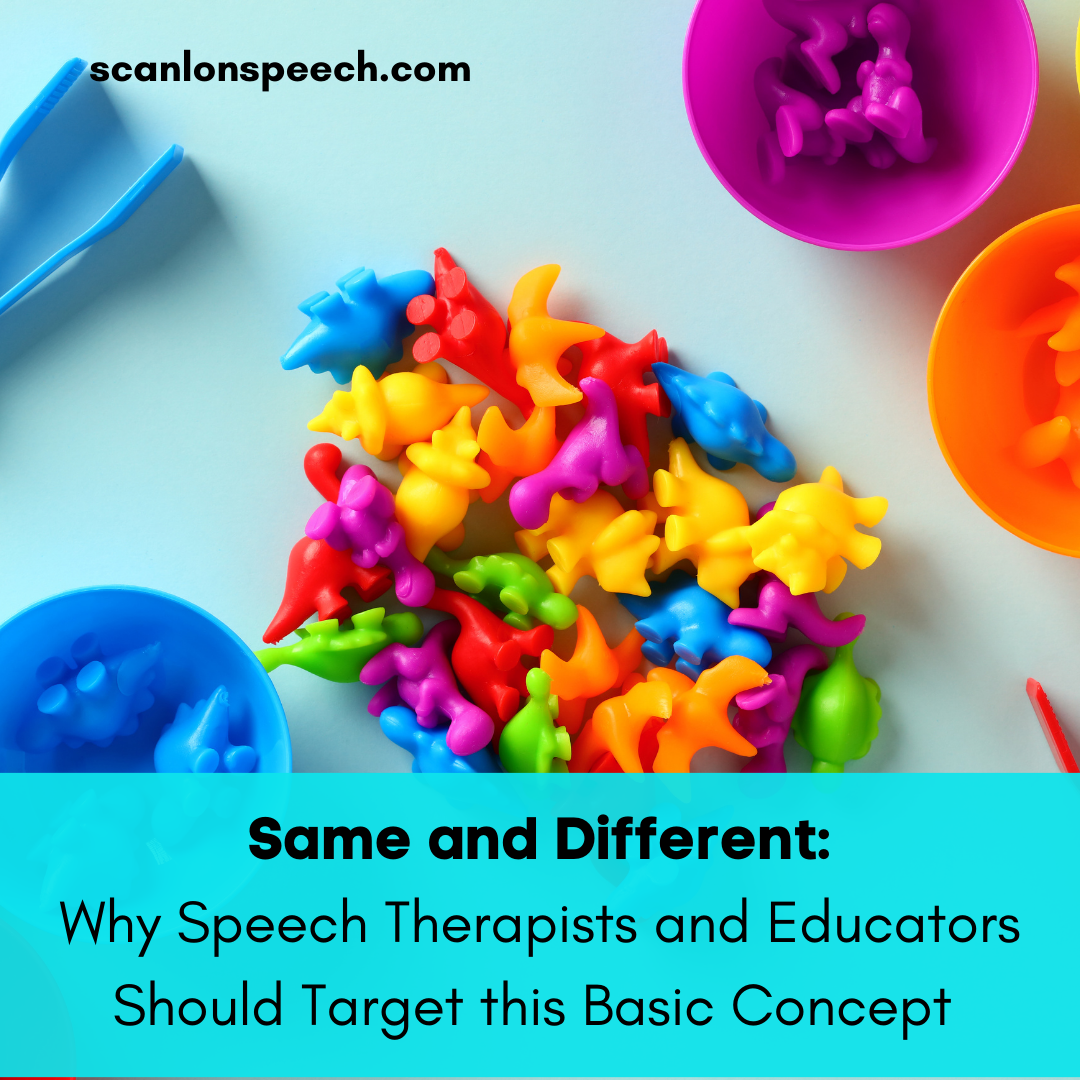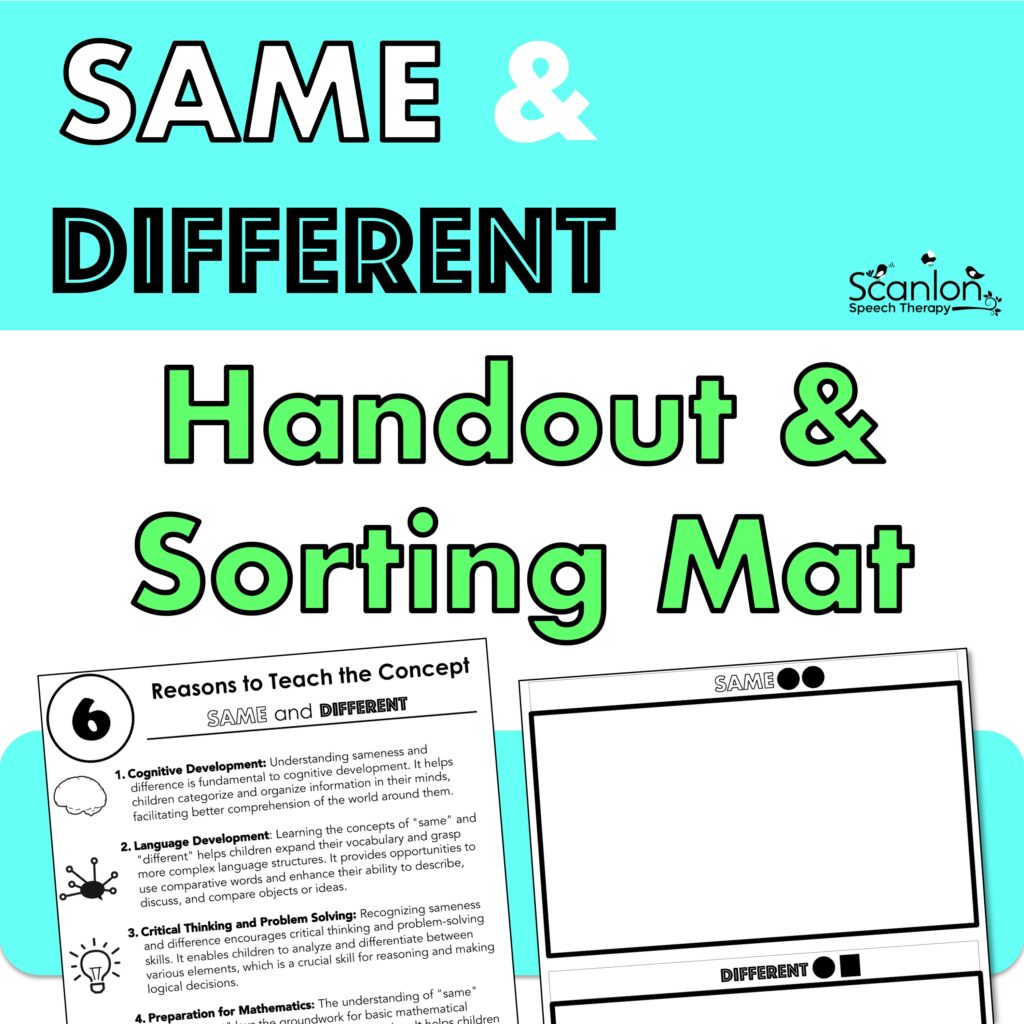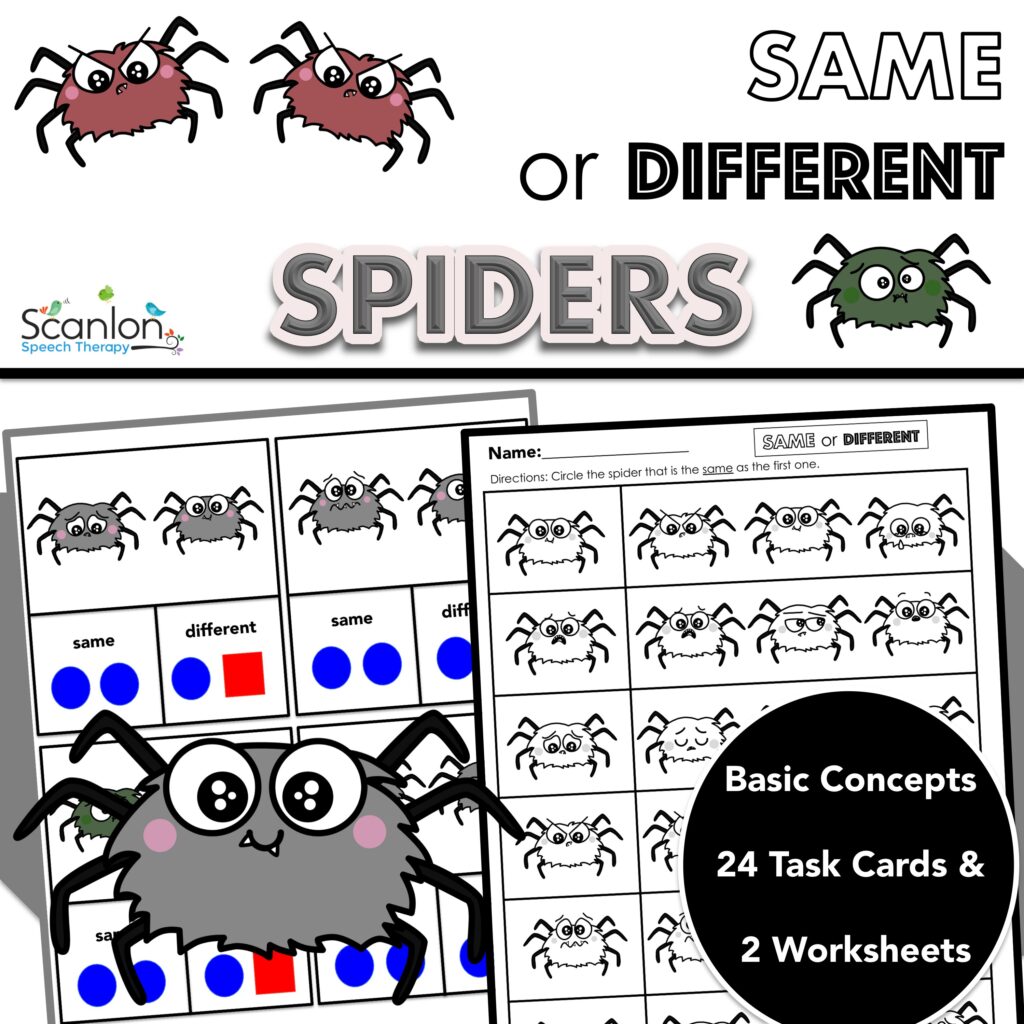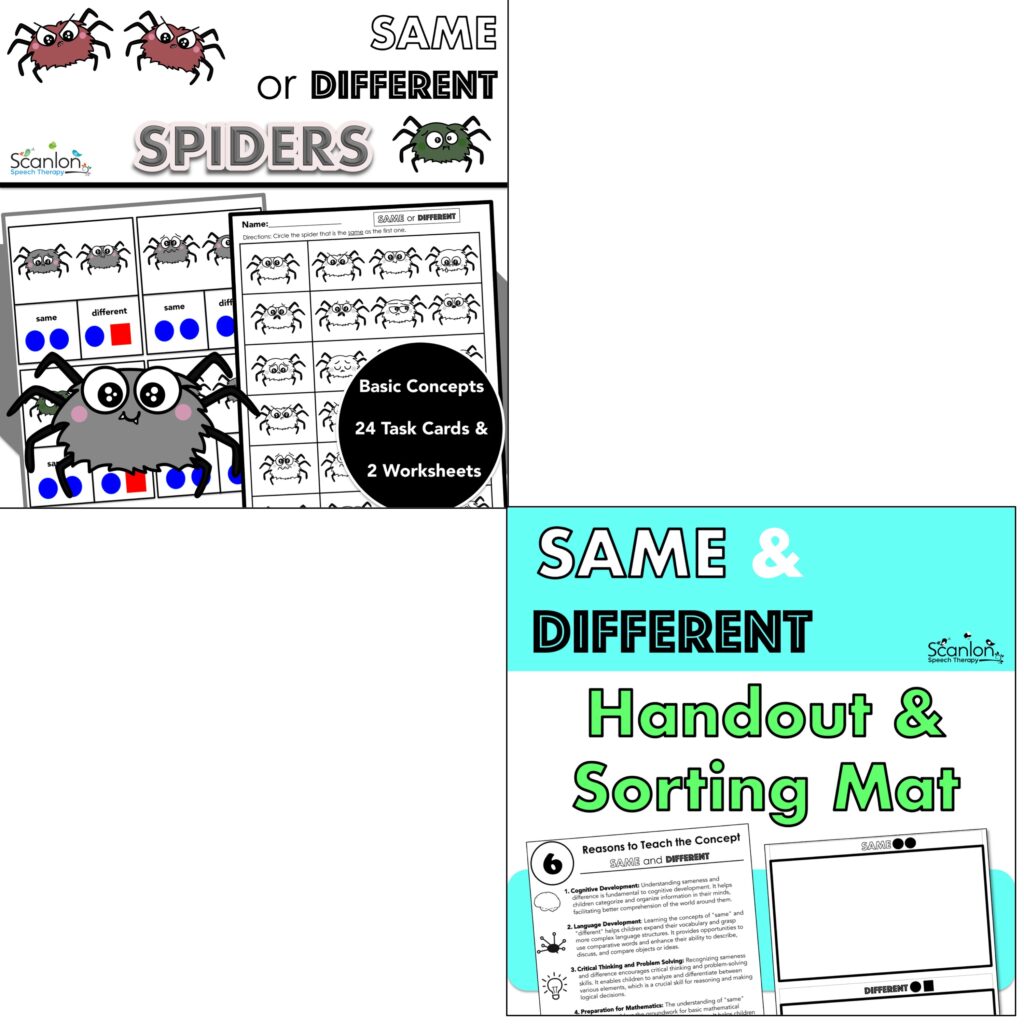Sign Up For Our E-Blast To Receive Information on our Books, Speech Therapy materials and our latest freebies!
Same and Different: Why Speech Therapists and Educators Should Target this Basic Concept

Have you ever wondered how young children perceive and understand the world around them?
Observing a child play or watching them explore sheds some light into what they are thinking. A child may pick up a fallen leaf and look at it but what else do they do?
Can they sort leaves into piles based on similarities and differences?
The basic concepts of same and different play a crucial role in shaping children’s cognitive and perceptual abilities.
If you’re a language buff, you probably know that same and different are adjectives and adjectives are words that describe nouns or pronouns.
Let’s delve into the essence of these adjectives by exploring their precise definitions as defined by Merriam Webster’s Dictionary. Their definitions are as follows:
- Same – “resembling in every relevant aspect”.
- In other words identical or exactly alike.
- Different – “partly or totally unlike in nature, form, or quality”.
- Therefore NOT the same or vary in how they look or what they are like.
Now let’s dive deeper because same and different are more than just unassuming adjectives; they serve as the foundation for a child’s understanding of size, shape, color, and quantity, laying the groundwork for a range of skills that shape their cognitive and perceptual abilities.
Same and different are one of several basic concepts.
Basic concepts are classified into categories based on properties or characteristics they have in common. They often come in pairs and typically have opposite counterparts.
Here are some categories of basic concepts:
- location (e.g. up/down)
- quantity or number (e.g. all none, more/less)
- quality or descriptions (e.g. big, little)
- time (e.g. old, young, yesterday, today)
- feelings (e.g. happy, sad)
When do children acquire the concepts of same and different?
Children typically grasp the concept of sameness before fully comprehending the concept of difference. Their understanding evolves as they mature, learn, and acquire more language skills. Moreover, the acquisition of sameness and difference isn’t a clear-cut, all-or-nothing process; it’s a continuum.
According to The Linguisystems Guide to Communication Milestones from 2012, between the ages of 2 and 3 years old, most children will select three objects that are the same from a set of four objects. They will also choose the object that is not the same from four objects when three are identical.
As they progress, between 3 and 4 years old, most children begin pointing to objects that are different from others.
By the ages of 4 to 5, they generally possess a solid understanding of differences.
Between 5 and 6 years old, most children can effectively respond to questions like, “How are things the same/different?” This question might be interpreted in two ways: either the child can determine how two things are different or the same and adequately describe those similarities and differences, or the child can justify why and how two things are the same or different. To determine this, one needs to consider Blank’s Levels of Questioning and exploring Blanks Levels of Questioning is best suited for a separate but closely related blog post. Regardless of whether we delve into this related but tangential topic, this complexity serves as a perfect example of why the fundamental skills of sameness and difference are instrumental in jumpstarting critical thinking.
It’s important for young children to learn how to identify things that are the same and different because it helps develop their cognitive and perceptual abilities.
Here are 6 reasons for children to learn about same and different and why explicit instruction is needed:
- Cognitive development: Discriminating between similarities and differences helps children develop their thinking and reasoning skills. It allows them to categorize objects, make comparisons, and understand basic concepts such as size, shape, color, and quantity. Organizing information this way facilitates better comprehension.
- Language development: Identifying similarities and differences helps children expand their vocabulary and develop language skills. When children learn to describe the similarities and differences between objects, they acquire new words and enhance their ability to communicate and express their thoughts.
- Problem-solving skills: Recognizing similarities and differences is essential for problem-solving. It enables children to analyze situations, find patterns, and make connections. These skills are crucial for logical reasoning and critical thinking, which are valuable for academic success and everyday life.
- Perceptual development: Identifying similarities and differences enhances a child’s visual and auditory perception. It helps them become more attentive to details, recognize patterns, and develop visual discrimination skills. These skills are essential for activities such as reading, writing, and mathematics.
- Social interaction: Understanding similarities and differences helps children relate to others and build social connections. They can recognize commonalities with their peers, appreciate diversity, and develop empathy and tolerance. It encourages them to appreciate different perspectives and engage in cooperative and inclusive play.
- Preparing for formal education: The ability to identify similarities and differences forms the basis of early math and literacy skills. It is a precursor to learning more advanced concepts in various subjects, including reading comprehension, science, and mathematics. It helps children understand concepts such as matching, sorting, sequencing, and pattern recognition. These skills are foundational for later academic learning and success in school.
For children with language disorders or learning disabilities, introducing and reinforcing these concepts is even more crucial. This is because these children may face challenges in language processing and expression, making it essential to break down abstract concepts like “same” and “different” into concrete, manageable parts.
By providing structured and individualized instruction, SLPs, educators and parents can help children with difficulties comprehend and apply these fundamental concepts, ultimately improving their overall language and cognitive development.
How do you support your students in grasping these fundamental concepts?
Share your strategies for teaching the concepts of ‘same’ and ‘different’?
Educators and speech-language pathologists (SLPs) hold a crucial role in guiding children through the understanding of these fundamental concepts. By providing explicit instruction tailored to individual needs, they empower children to navigate the complexities of “sameness” and “difference,” ultimately enhancing overall language and cognitive development.
To further support this journey, I’m offering a free handout that provides insightful reasons for teaching these concepts. Additionally, for educators and SLPs seeking practical tools, I have a free sorting map designed to facilitate the teaching of “same” and “different.” This resource can be an effective aid in creating engaging activities that promote understanding and application of these foundational concepts in the classroom.
Empowering children with a solid grasp of “same” and “different” sets the stage for a lifetime of successful learning, and with collaborative efforts from educators, SLPs, and parents, we can pave the way for brighter futures.
- Enhance Your Speech Therapy Sessions with ‘Picky Kitty’ – A Must-Have Game for Every Speech Therapist
- Same and Different: Why Speech Therapists and Educators Should Target this Basic Concept
- New Beginnings for Scanlon Speech Therapy
- Articulation Speech Therapy: Favorite Activities, Games, and Books to Target the TH Sounds
- Articulation Speech Therapy: Favorite Activities, Games and Books to Target the L Sound



